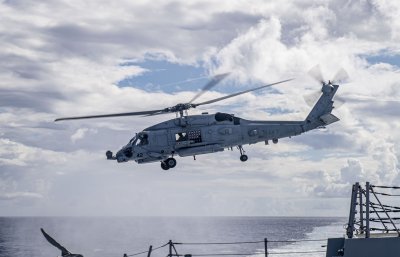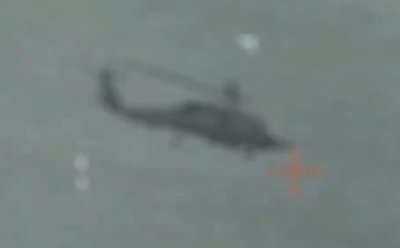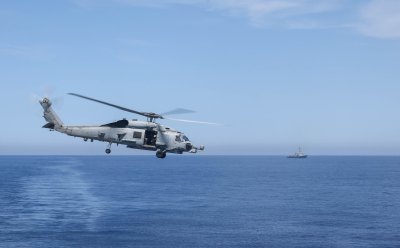
Chinese television aired footage on Friday of what it said was a close encounter near China’s coast between its military and a suspected U.S. naval helicopter.
The incident happened in the Taiwan Strait, according to state broadcaster CCTV, which released pixelated silhouettes of a foreign military rotorcraft resembling an American-made Sikorsky MH-60R Seahawk, a shipborne helicopter used by the United States and a number of allied militaries in the Pacific.
The Chinese military did not say when the encounter took place, only that the foreign aircraft had been approaching Chinese airspace. China‘s Defense Ministry did not immediately respond to a written request for comment after hours.
The U.S. Defense Department and the U.S. Navy‘s Japan-based Seven Fleet—responsible for operates in the West Pacific—did not return a request for confirmation before publication.
Why It Matters
The Taiwan Strait, a busy trade route about 80 miles wide at its narrowest point, separates China from the U.S.-backed, self-ruled island of Taiwan, which Beijing claims as its own despite Taipei’s objections.
China’s claim to Taiwan extends to the sea areas around the island, which it argues do not permit maneuvers by military vessels like the one that had likely launched the MH-60R shown in the Chinese military’s video.
Although the United States does not formally recognize Taiwan—it considers the island’s postwar status undetermined—it also does not accept China’s maritime claims. Successive U.S. administrations have for years sent ships and aircraft through the strait to assert freedom of navigation and overflight under international law.
Beijing’s disclosure, which coincided with the 98th anniversary of the Chinese People’s Liberation Army, was another reminder of the entrenched military rivalry between the two powers even as their leaders seek an amicable resolution to the ongoing trade war.
CCTV

Mass Communication Specialist 2nd Class Peter K. McHaddad/U.S. Navy
The Claim
The footage aired on August 1 showed a Changhe Z-10, an attack helicopter used by both China’s army and air force, intercepting the suspected MH-60R in what the state-owned Chinese tabloid Global Times called a “high-stakes aerial standoff.”
Kong Xianghui, the Chinese army aviation pilot operating the Z-10, told CCTV that the foreign rotorcraft was around three miles from China’s territorial sea. He issued radio challenges before approaching the helicopter in an ensuing encounter that lasted over an hour, he said.
Kong said the foreign military pilot flew into the clouds and then reemerged speeding toward him from the left before turning away at a distance of around 500 meters, or 1,650 feet.
“The action was extremely unprofessional and designed to provoke. We will never allow this on our doorstep,” Kong said, in a rebuke that mirrored similar accusations by the United States and its allies against Beijing’s pilots.
CCTV hailed the Chinese military for expelling the foreign aircraft at an “extreme distance.”
Unpacking the Encounter
The MH-60R is a multi-mission rotorcraft developed from the UH-60 Black Hawk used by the U.S. Army. The Seahawk can perform anti-submarine warfare, anti-surface warfare, search and rescue, and at-sea supply missions, among other tasks, from Navy warships including aircraft carriers and destroyers.
In May, South Korea received the first of 12 MH-60R helicopters ordered from the United States, but they will not enter service until 2026.
Su Tzu-yun, a senior research fellow at the Institute for National Defense and Security Research in Taipei, told Newsweek: “Currently in Northeast Asia, only the United States and South Korea have the MH-60R. It was most likely the U.S. military that had approached China’s territorial waters.”
“In the footage, the pilot identifies himself as a member of Chinese army aviation, which shows it must have happened in waters near China’s Eastern Theater Command area, hence the deployment of an army helicopter,” Su said.
He said: “Releasing the footage on August 1 serves as domestic propaganda to demonstrate the military’s contributions.”

CCTV

Mass Communication Specialist Seaman Whitten Helton/U.S. Navy
What the Law Says
Under the United Nations Convention on the Law of the Sea (UNCLOS), also known as the Law of the Sea Treaty, a state is granted a “sovereign right” to resources within an exclusive economic zone that extends 200 nautical miles (230 miles) beyond its territorial waters. A state’s “sovereignty,” however, ends after the 12-nautical-mile (13.8-mile) limit of its territorial sea.
In Beijing’s reading of the law, it has jurisdiction over the Taiwan Strait, although it has stopped short of labeling the area part of its internal waters, an interpretation that would greatly disrupt commercial shipping in the waterway.
UNCLOS permits military vessels to transit the territorial waters of a coastal state, in what is known as “innocent passage.” However, transiting ships are not allowed to conduct weapons training or launch aircraft. U.S. navigational practices aim to show that it sees the Taiwan Strait as existing beyond the jurisdiction of any coastal state.
During 2020-2021, U.S. warships or Navy planes publicly transited the Taiwan Strait on a monthly basis, drawing criticism from China each time.
The Trump administration has sanctioned three strait transits this year, including an overflight in mid-July. There were nine transits in 2024 and 11 in 2023.
The last Navy ship to publicly enter the waters between China and Taiwan was the Arleigh Burke-class guided-missile destroyer USS William P. Lawrence in April. The Flight IIA variant of the destroyer—introduced in 2000—can carry two MH-60R helicopters.
Like U.S. freedom of navigation operations in the South China Sea, public transits through the Taiwan Strait are designed to challenge Beijing’s maritime claims. However, the waterway is commonly used by all vessel types daily.
In early July, after online data showed a ship entering the Taiwan Strait while broadcasting as a “U.S. government vessel,” the Seventh Fleet told Newsweek that “no U.S. Navy assets” had conducted a strait transit at the time.
